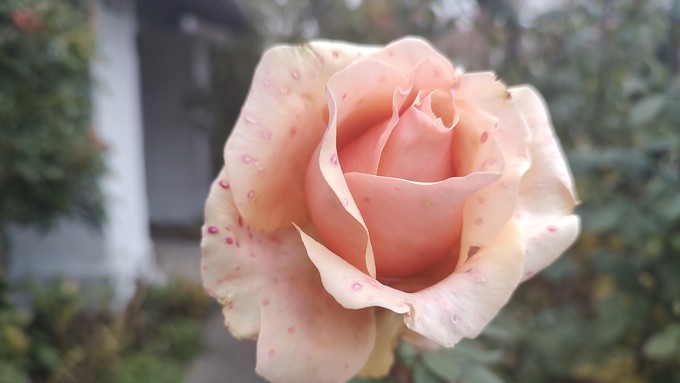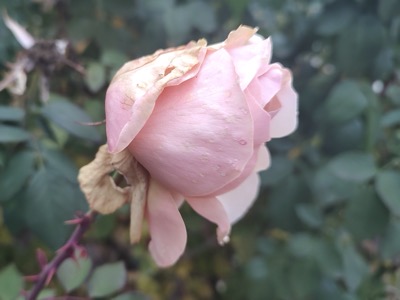
Botrytis outbreak on roses, poinsettias follows chilly, damp weather

This Marilyn Monroe rose is showing early signs of botrytis: The red spots are the symptoms. Debbie Arrington
Sacramento experienced record cold weather this past weekend and thick damp fog that seemed to just hang around.
How will this combination of cold and damp affect our gardens? A rapid shutdown to dormancy. Any fall foliage clinging to branches is dropping now.

This weather also kicks some fungal diseases into high gear. My roses saw a massive attack of botrytis – gray mold – and it’s not pretty.
According to the National Weather Service, downtown Sacramento recorded lows of 32 degrees on Dec. 17 and 18 – records for both dates. With relentless fog, Sunday (Dec. 18) was the coldest day in downtown Sacramento since January 2001; the high topped out at 42.
The fog is linked to all our ground moisture, thanks to recent rains. Lack of wind and sun keeps the fog trapped close to the ground. And that fog creates ideal conditions for gray mold.
Gray mold – which actually looks more tan or brown on the rosebud – needs moisture for growth in plant tissues, particularly tender flower petals. To prevent outbreaks, keep flower buds dry. That’s all but impossible on damp, foggy days.
Thanks to dry and warm fall weather, I had dozens of rose buds in my garden and was hoping to make some Christmas bouquets. But after so much fog and frosty nights, I’ll have few if any roses for my holiday table.
Gray mold starts out looking like pink measles or brownish water spots on light-colored flowers. Those brown spots rapidly grow until the fungus consumes the whole petal. The flower never fully opens.
Another victim to gray mold this season: Poinsettias. If left outside, they turn to mush.
Gray mold also attacks African violet, asters, begonia, carnation, chrysanthemum, cyclamen, cymbidium, gerbera, geranium, gladiolus, hydrangea, marigolds, orchids, petunia, primrose, ranunculus, snapdragon, zinnias and many other garden favorites.
According to UC Integrated Pest Management program, the best control of gray mold is “good sanitation.” Clip off infected blooms, put them in a plastic bag and dispose of them in the trash. Do not compost them; that just recycles the spores back into the garden. Pick up fallen blooms and petals around the bush and dispose of them, too.
(Since this is already pruning time, I’ll remove those infected blooms in a pass through my garden before I tackle pruning the canes.)
After pruning, rake out old mulch and fallen foliage. (This contains other fungal spores, too, for powdery mildew, rust, black spot and other rose diseases.) Then, dispose of that old mulch and replace it with fresh mulch.
For more information on gray mold, check out these pest notes from UC IPM: http://ipm.ucanr.edu/PMG/r280100511.html
Comments
0 comments have been posted.Sacramento Digs Gardening to your inbox.
Sites We Like
Garden Checklist for week of July 21
Your garden needs you!
* Keep your vegetable garden watered, mulched and weeded. Water before 8 a.m. to reduce the chance of fungal infection and to conserve moisture.
* Feed vegetable plants bone meal, rock phosphate or other fertilizers high in phosphate to stimulate more blooms and fruiting. (But wait until daily high temperatures drop out of the 100s.)
* Don’t let tomatoes wilt or dry out completely. Give tomatoes a deep watering two to three times a week.
* Harvest vegetables promptly to encourage plants to produce more. Squash especially tends to grow rapidly in hot weather. Keep an eye on zucchini.
* Pinch back chrysanthemums for bushy plants and more flowers in September.
* Remove spent flowers from roses, daylilies and other bloomers as they finish flowering.
* Pinch off blooms from basil so the plant will grow more leaves.
* Cut back lavender after flowering to promote a second bloom.
* It's not too late to add a splash of color. Plant petunias, snapdragons, zinnias and marigolds.
* From seed, plant corn, pumpkins, radishes, winter squash and sunflowers.